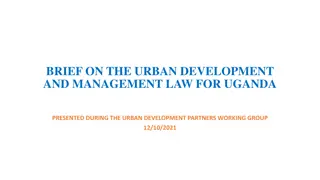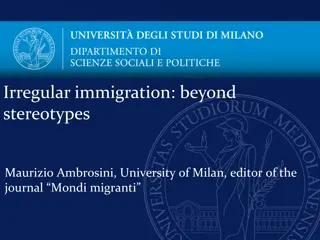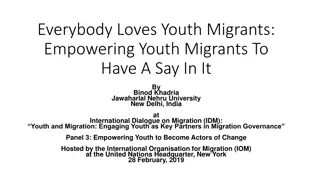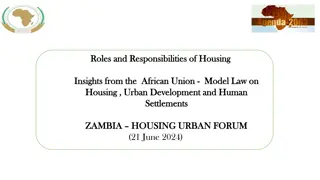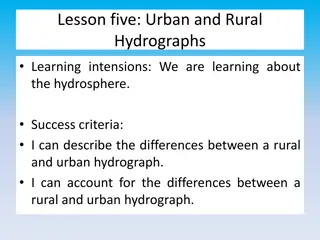Churn Prediction for Urban Migrants: Integrating Mobile Communication Networks
Urban migration poses challenges such as segregation and social inequality. This study explores migrant integration using mobile communication data, focusing on the initial period and early departure rates of new migrants in Shanghai. Insights into classification trends and departure patterns provide valuable information for urban planning and policymaking.
Download Presentation

Please find below an Image/Link to download the presentation.
The content on the website is provided AS IS for your information and personal use only. It may not be sold, licensed, or shared on other websites without obtaining consent from the author. Download presentation by click this link. If you encounter any issues during the download, it is possible that the publisher has removed the file from their server.
E N D
Presentation Transcript
To Stay or to Leave: Churn Prediction for Urban Migrants in the Initial Period Yang Yang1, Zongtao Liu1, Chenhao Tan2, Fei Wu1, Yueting Zhuang1, Yafeng Li3 1Zhejiang University 2University of Colorado Boulder 3China Telecom 1
Urban Migrants In China, 260 million people migrate to cities to realize their urban dreams. Urban migrants also pose great challenges including segregation and social inequality. Understanding migrant integration helps policymakers with urban planning. We conduct quantitative explorations of migrant integration based on mobile communication networks. 2
Telecommunication Metadata born in One-month complete call data in Shanghai Beijing born in Shanghai 698M+ call logs and 54M+ users provided by China Telecom1 Male Age: 31 born in Hangzhou 1. China Telecom Corporation is a Chinese state-owned telecommunication company and the third largest mobile service providers in China. 3
Integration and Disintegration Migrant Integration We observe an increasing trend for new migrants misclassified as locals over the three weeks .1 Fraction of migrants classified as locals. 1. Yang Yang,Chenhao Tan, Zongtao Liu, Fei Wu, and Yueting Zhuang. Urban Dreams of Migrant: A Case Study of Migrant Integration in Shanghai. AAAI 18. 4
Integration and Disintegration Migrant Integration We observe an increasing trend for new migrants misclassified as locals over the three weeks .1- Departure of New Migrants Around 4% of new migrants ended up leaving early. To Stay or to leave? Initial period of a migrant s integration process in Shanghai A migrant s first step -> Eventual integration 1. Yang Yang,Chenhao Tan, Zongtao Liu, Fei Wu, and Yueting Zhuang. Urban Dreams of Migrant: A Case Study of Migrant Integration in Shanghai. AAAI 18. 5
How Many Migrants are Leaving in the First Weeks? Based on people s birthplaces and call history, we define locals and new migrants: Locals: who were born in Shanghai New migrants: who were not born in Shanghai and had no call logs in the first 4 days in our dataset 6
How Many Migrants are Leaving in the First Weeks? Based on people s birthplaces and call history, we define locals and new migrants: Locals: who were born in Shanghai New migrants: who were not born in Shanghai and had no call logs in the first 4 days in our dataset 7
How Many Migrants are Leaving in the First Weeks? Based on people s birthplaces and call history, we define locals and new migrants: Locals: who were born in Shanghai New migrants: who were not born in Shanghai and had no call logs in the first 4 days in our dataset 8
How Many Migrants are Leaving in the First Weeks? Based on people s birthplaces and call history, we define locals and new migrants: Locals: who were born in Shanghai New migrants: who were not born in Shanghai and had no call logs in the first 4 days in our dataset 9
How Many Migrants are Leaving in the First Weeks? Based on people s birthplaces and call history, we define locals and new migrants: Locals: who were born in Shanghai New migrants: who were not born in Shanghai and had no call logs in the first 4 days in our dataset 1.8M locals, 34K staying migrants and 1.5K leaving migrants. 10
The (Dis)integretion of Migrants Q1: What kind of people tend to start with a less dense group? Leaving migrants or staying migrants? 11
Leaving migrants start with a denser group Q1: What kind of people tend to start with a less dense group? Leaving migrants or staying migrants? clustering coefficient: the fraction of triangles in the ego-network and indicates how likely a person s contacts know each other 12
The (Dis)integretion of Migrants Q2: What kind of people tend to have less diverse connections? Leaving migrants or staying migrants? 13
Leaving migrants tend to have less diverse connections Q2: What kind of people tend to have less diverse connections? Leaving migrants or staying migrants? townsman: the fraction of v s contacts born in the same province province diversity: entropy of the distribution of birth provinces among v s contacts communication diversity: Shannon entropy of the distribution of the number of calls to their contacts 14
The (Dis)integretion of Migrants Q3: What kinds of people tend to be active at more expensive area? Leaving migrants or staying migrants? (a) Housing price distribution in Shanghai 15
Leaving migrants tend to stay in most expensive area Q3: What kinds of people tend to be active at more expensive area? Leaving migrants or staying migrants? (a) Housing price distribution in Shanghai (b) Avg. housing price of users active areas. 16
The (Dis)integretion of Migrants Feature sets: Ego network properties Call behavior Geographical patterns Housing price information 17
Classification Tasks New Migrants (35K) vs. Locals (1.7M) Leaving Migrants (1.4K) vs. Staying Migrants(34K) leaving migrant? new migrant? Mobile networks user v staying migrant? local? Task 2 Task 1 18
New Migrants from Locals New Migrants(35K) vs. Locals(1.7M) Classifier: random forest 5-fold cross-validation 19
New Migrants from Locals New Migrants(35K) vs. Locals(1.7M) Classifier: random forest 5-fold cross-validation 20
Churn prediction problem Leaving Migrants(1.4K) vs. Staying Migrants(34K) Classifier: random forest 5-fold cross-validation 21
Churn prediction problem Early detection of leaving migrant Is it possible to detect leaving migrants sooner than two weeks? If so, we may be able to provide integration service. We extract features based on one s information from the first k days. 22
Churn prediction problem Why does the performance improve? We disentangle the improvement due to feature quality or classifier quality k-day features t-day features test train classifier Predict leaving migrant 23
With the first 5 days data, the classifier performs as well as those trained using 14 days Why does the performance improve? We disentangle the improvement due to feature quality or classifier quality k-day features t-day features test train classifier Predict leaving migrant 24
Summary We study the problem of early departure of new migrants. Leaving migrants develop less diverse connections and their active areas also have higher housing prices than that of staying migrants.. Classification performance improves over time, mainly because the features become more robust. Thank you! Q&A QR code for housing price data: 25
Appendix: Telecommunication in China Obtaining a local number is the first integration step for a new migrant Long-distance call cost It is uncommon for a temporary visitor to obtain a local number obtaining a phone number is nontrivial and requires personal identification We can identify people who just obtained a local number but were not from Shanghai originally. Personal identification allows us to extract the birthplace of a person. 26















